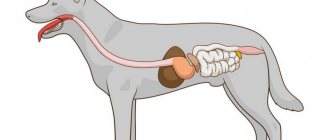What to do for itchy skin at home - bathing and care
This may not seem like a “natural” remedy, but if your dog suffers from environmental allergies, frequent baths will provide much-needed comfort. Using soothing ingredients such as oatmeal in shampoos is beneficial to the skin and relieves the itching your dog feels. Depending on the severity of the allergy, bathing once a week will significantly improve the condition. Brushing and brushing will also help remove dead skin (the dead layer of skin - epidermis) and shed hair, promoting the body's natural regeneration and new growth of a healthy, shiny coat.
Symptoms
Depending on the disease that caused the itching, different accompanying symptoms will be observed. If your dog scratches his ears and whines, this is a clear sign that he is in pain. This can even lead to attacks of aggression, especially when a person touches a sore spot. Pain in the ears and jaws when chewing often accompanies otitis media. The animal also tilts its head to the side, thereby reducing the pressure inside the ear.
Infectious otitis media occurs with fever, weakness, and loss of appetite. The auricle turns red and becomes hot, a putrid odor emanates from it, and the ear canal becomes covered with purulent crusts. If your pet has otitis media or internal otitis media, his hearing will begin to deteriorate, which may result in complete hearing loss. An allergic reaction is indicated by constant scratching of the ears and eyelids after contact with an allergen. With allergic eczema, small bubbles with liquid contents form in the ears.
READ ALSO: Lipoma removal surgery - “Instead of 20 minutes, 1 hour lipoma removal surgery
If a dog scratches its ears until it bleeds, shakes its head and bends it towards the ground, this indicates unbearable itching, caused by a tick. With this disease, a dark liquid is released from the ears, which quickly dries out and forms crusts, and on the outer side of the auricle the fur thins and wounds from scratching appear.
Healthy diet against skin allergies
The diet may seem unimportant to the owner if the dog suffers from environmental allergens. But the more natural the animals eat, the better their bodies are able to fight and heal from reactions to external stimuli. And in the case of an allergy to certain ingredients in food, it would be logical to avoid the appearance of allergens in the daily diet. Grain-free diets are highly recommended for pets with allergies. But if this option is not acceptable, then you can try to use only organic whole grains. The better and more natural your pet's diet, the better the overall health and the greater the ability to fight allergens.
What to apply to a dog for itchy skin - the beneficial properties of apple cider vinegar
Natural, raw, unfiltered apple cider vinegar can be a good remedy for a pet suffering from allergic skin dermatitis. If your dog has itchy skin, you can mix apple cider vinegar and water 1 to 1. Place the solution in a spray bottle for easy use. In addition, this spray repels fleas and ticks, which not only carry serious diseases, but can also cause an allergic reaction. You can also use the solution to clean your dog's ears. The acidity of the mixture creates conditions in which the yeast cannot live, and yeast infections usually cause allergies. Make sure the acidity is not too high for your dog - alternatively, you can reduce the percentage of vinegar by adding more water.
Pyoderma in dogs - causes and development
The first point in taking a medical history is the presence of parasites; you need to say when the dog was last treated for fleas and ticks. Since prevention does not guarantee, the doctor will definitely examine the four-legged skin for bites, waste products and fleas themselves. Red dots are bite marks, clearly visible on the stomach, where there is no fur. Flea scratches can appear all over the body, in the form of scratches on the sides and neck, in the form of weeping wounds above the tail and on the thighs.
We suggest you read: How to identify subcutaneous mites
A common cause of localized itching is mites that parasitize the skin. When infected with ear mites, the dog scratches its head and ears within just a few days. The subcutaneous mite can cause numerous bald patches throughout the body. To confirm or refute the diagnosis, a skin scraping is taken from the dog.
The study determines not only the presence of parasites, but also their type. The fact is that lice are much smaller than fleas, and lice eaters are not at all possible to see without the appropriate equipment. Treatment, or more precisely, its effectiveness depends on the spectrum of action of the drugs - medicine for ticks will not help against lice and vice versa.
In a similar research method, the affected areas of the skin are checked for the presence of fungal cultures. All kinds of lichen are the result of a riot of unfriendly microorganisms that have found favorable conditions for reproduction. Fungi and even a microscopic mite that causes demodicosis constantly live on the body of a healthy dog.
As long as the animal is healthy and its immunity is functioning normally, there is no need to worry about microsporia or demodicosis. If feeding is improper, after an illness or major surgery, the level of immune protection may drop. The sudden appearance of multiple foci of inflammation and scratching does not indicate itching, but some kind of extensive illness.
The causes of generalized or partially localized itching are more varied, but are most often associated with allergies. Any dog, even the pickiest one, can develop an allergic reaction to food. This reason is especially likely if the animal eats cheap dry food, which is generously flavored with dyes, preservatives and flavor enhancers.
After 2–3 days, the dog’s diet begins to be supplemented with familiar foods. After each innovation, the condition of the four-legged animal is observed for 3–4 days. If the dog is not bothered and the scratches continue to heal, the next product is introduced. In difficult cases or when the owner does not have time for observation, the dog is immediately switched to high-quality hypoallergenic industrial food.
A more complex option is non-food allergies. The difficulty is that determining the source of allergens is very difficult. The first step is to replace all bowls, anti-parasitic collar, bed, toys and other accessories that are in constant contact with the pet. All recently purchased bathing accessories and products are removed from use. Until the acute condition is completely eliminated, the animal should receive complex antihistamine therapy.
Seasonal allergies to pollen, spores and dust are also classified as non-food allergies. It is impossible to completely stop the dog’s body’s reaction to the external environment, so the doctor prescribes seasonal therapy. Long-term use of antihistamines is not addictive, but may have a detrimental effect on effectiveness. The drugs are either alternated or prescribed in courses. During seasonal allergies, it is advisable to keep the dog on a diet and not resort to bathing with shampoos unless absolutely necessary.
Atopic dermatitis is another cause of severe itching and scratching, the problem is that it cannot be cured. Atopy has no established causes; it arises abruptly and most often also goes away unexpectedly. Naturally, the pet’s condition cannot be ignored; taking antihistamines and treating scratches is carried out throughout the entire acute period.
Pyoderma is caused by several reasons. The main reason is a decrease in immunity. A decrease in the body's defenses occurs as a result of a change in living conditions, feeding or movement. For example, a dog has been constantly kept indoors (apartment or house) and is sent to live outside. Or a dog that constantly lived in the courtyard of a private house is taken to live in an apartment.
Changing feeding affects the immune system not only when reducing calories. The dog gets its main source of antibodies, protein, from meat. To save money, meat is often replaced with offal and entrails. Such a replacement, even while maintaining the energy value of the food, reduces the nutritional value and cannot meet the dog’s needs. You should adhere to the recommended ratio of meat, offal and slaughterhouse waste, and cereals for the breed.
Switching adult dogs to dry or canned food exacerbates a number of chronic diseases that reduce immunity. After about one and a half to two months, these processes return to normal. Immunity is fully restored 4 months after switching to dry food.
We suggest you read: Yorkie has fleas
It is necessary to take into account the relationship between movement and feeding. So, during training, a dog requires about 15 - 20% more food. During intensive work, the needs increase up to 40%.
Lack of exercise is just as harmful for dogs as too much. If there is a lack of movement, the skin does not cleanse itself. Dust, dead pieces of skin, and various secretions accumulate in the wool, serving as food for microbes.
A secondary cause of pyoderma is considered to be a violation of the integrity of the skin. So, running through the meadows in the fall, puppies often injure the skin of their abdomen on dry grass. The short hair of Bulldogs, Bullmastiffs and Shar-Peis scratches the skin in the folds.
Worms, fleas and microscopic mites contribute to the development of pyoderma. The presence of parasites reduces immunity. In addition, fleas and microscopic mites damage the skin. The skin in folds on the face (in bulldogs and similar breeds), near the genitals and on the abdomen (in large breed puppies) is especially susceptible to pyoderma.
How to treat skin allergies - Omega fatty acids
Omega-3 fatty acids are extremely beneficial for dogs with allergies. These oils help improve the condition of your pet's skin and coat. Omega-3 also works as an anti-inflammatory agent and significantly reduces the intensity of allergens.
It may not be possible to relieve a dog’s allergy during its acute manifestation using natural means; they are designed for long-term use, during which the animal recovers. Natural remedies also speed up the healing process, because itching in dogs provokes the appearance of wounds and ulcers as a result of frequent scratching and biting at the affected areas. And of course, we must try to remove the cause of the allergy, and not just fight the symptoms of the disease.
Please follow and like us:
Nikitin Sergey
I write about dogs based on the experience and knowledge gained during my studies as a veterinarian, work in my specialty, and simply from observing my pets.
Allergies in dogs: symptoms
In order to diagnose a food allergy, a special diagnosis is carried out, which is called an elimination diet. At first, foods that are part of the dog’s usual diet are removed from the dog’s diet, and then they are gradually returned. After this, the dog’s owner looks at which product was administered when the relapse occurred. Most often, this diet is introduced with full confidence that the dog does not have fleas, scabies mites, and other pathogens that provoke severe itching and hair loss in certain places.
Allergies in dogs, symptoms:
- Allergies in four-legged friends manifest themselves in the same way as in people. Usually this is redness of the eyes, discharge of a large amount of mucus from the nose and mouth, rashes, redness, and severe itching.
- In general, the dog may feel quite unwell and may feel unwell. However, the temperature remains normal.
- Typically, allergy rashes appear on the face, ears, and in the folds of the skin, under the paws. Often redness and pimples appear in these areas, which the dog may scratch.
READ ALSO: Watery pimples on fingers and palms: causes, methods of treatment and prevention |
Cute dogs











